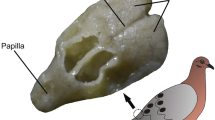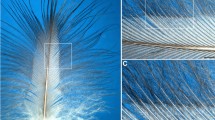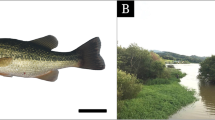Summary
The scincid lizardTiliqua rugosa possesses a large external nasal gland which is located intraconchally. Highly ramified tubules, imbedded primarily in the periphery of the gland, unite to form collecting ducts which empty into a short excretory canal. The diameter of the tubules increases progressively from 30Μ. at the distal extremity of the gland to over 200Μ at the level of the collecting ducts. The intraglandular portion of the excretory canal is often dilated to form an ampulla. The thickness of the epithelium increases from 12Μ at the level of the tubules to 25–30Μ in the excretory canal.
The excretory canal is lined with an epidermal epithelium close to the point where it enters the vestibule. In all the rest of the gland the tubules are lined with two cell types: large, typical muco-serous cells and “striated” cells. At the distal end of the tubules the “striated” cells are narrow and poorly differentiated and alternate more-or-less regularly with the muco-serous cells. The relative proportion of these “striated” cells increases progressively, as does their size, as one moves proximally down the tubule. In the gland as a whole the “striated” cells are approximately twice as numerous as the muco-serous cells but, due to their smaller size, they occupy less than one third of the tubular volume.
Electron microscopy of the “striated” cells ofTiliqua rugosa revealed the presence of extensive lateral interdigitations and expansions of the basal cytoplasmic membrane, anatomical specialisations which are normally indicative of active salt transport. These modifications are less marked however than in the external nasal glands of the lizardsLacerta muralis andVaranus griseus, which do not appear to function as salt glands. In addition there are few mitochondria present, although they are of large size. The combination of these ultrastructural features, plus the fact that the “striated” cells are intermixed with muco-serous cells in the tubules, makes it most unlikely that the external nasal gland ofTiliqua rugosa is capable of elaborating an hyperosmotic fluid. What is more, this has never been conclusively demonstrated in this species in physiological studies.
The progressive specialisation of the “striated” cells from the distal to the proximal section of the tubules poses the problem of the origin and differentiation of this cell type.
A review of results obtained from the study ofTiliqua rugosa and other species of lizards shows that the nature of the relationship between structure and function of the external nasal gland is far from clear. The existence of “salt glands”, capable of excreting hyperosmotic solutions, is invariably linked with the presence in the gland of well-developed “striated segments” composed almost entirely of cells possessing extensive interdigitations of the lateral membranes. Amongst terrestrial lizards, nasal salt glands are usually found in herbivorous species and they are primarily adapted to the extrarenal excretion of potassium ions. The problem for carnivorous species is more often that of an excess of sodium rather than potassium ions and with the possible exceptionAcanthodactylus species, functional nasal salt glands have not been demonstrated in terrestrial carnivores, despite the presence in some cases of well-developed “striated segments” in the gland having a similar structure to those found in herbivores. In humid regions, carnivorous lizards probably never require extrarenal excretory mechanism and in arid regions their survival is assured by their capacity to tolerate hypernatraemia when confronted with excessive salt loads. Salt glands capable of eliminating sodium ions to any extent have only been described in two littoral species, an herbivorous iguanid and a carnivorous varanid. Unfortunately the structure of their respective nasal glands has not yet been described and their further study would be desirable.
Similar content being viewed by others
Bibliographie
Bentley, P.J.: Studies on the water and electrolyte metabolism of the lizardTrachysaurus rugosus (Gray). J. Physiol.145, 37–47 (1959)
Bradshaw, S.D., Shoemaker, V.H.: Aspects of water and electrolyte changes in a field population ofAmphibolurus lizards. Comp. Biochem. Physiol.20, 855–865 (1967)
Braysher, M.: The structure and function of the nasal salt gland from the australian sleepy lizardTrachydosaurus (formerlyTiliqua) rugosus: family Scincidae. Physiol. Zool.44, 129–136 (1971)
Dunson, W.A.: Salt gland secretion in a mangrove monitor lizard. Comp. Biochem. Physiol.47, 1245–1255 (1974)
Duvdevani, I.: The anatomy and histology of the nasal cavities and the nasal salt gland in four species of fringed-toed lizards,Acanthodactylus (Lacertidae). J. Morphol.137, 353–364 (1972)
Ellis, R.A., Goertemiller, C.C., DeLellis, R.A., Kablotsky, Y.H.: The effect of a salt water regimen on the development of the salt glands of domestic ducklings. Dev. Biol.8, 286–308 (1963)
Ernst, S.A., Ellis, R.A.: The development of surface specialisation in the secretory epithelium of the avian salt gland in response to osmotic stress. J. Cell. Biol.40, 305–321 (1969)
Gabe, M., Saint Girons, H.: Contribution à la morphologie comparée des fosses nasales et de leurs annexes chez les Lépidosauriens. Mém. Mus. Nat. Hist. nat. ParisA98, 1–87 (1976)
Gerzeli, G., De Piceis Polver, P.: The lateral nasal gland ofLacerta viridis under different experimental conditions. Monitore Zool. ital.4, 191–200 (1970)
Lemire, M.: Etude anatomo-histologique de l'organe nasal du Lézard saharienUromastix acanthinurus Bell 1825 (Sauria, Agamidae). Problèmes posés par l'adaptation au milieu. Thése, Université de Paris VI, 131 p. (1975)
Lemire, M., Deloince, R.: Variabilité de la glande nasale externe chez quelques Lézards déserticoles. C.R. Acad. Sc. Paris284, 2269–2272 (1977)
Minnich, J., Shoemaker, V.: Water and electrolyte turnover in a field population of the lizard,Uma scoparia. Copeia 650–659 (1972)
Saint Girons, H., Joly, J.: Histologie et ultrastructure de la glande nasale externe du LacertilienLacerta muralis et de l'AmphisbénienTrogonophis wiegmanni (Reptilia, Lacertidae et Trogonophidae). Arch. Biol. (Bruxelles)86, 97–126 (1975)
Schmidt-Nielsen, K., Fange, R.: Salt gland in marine Reptiles. Nature nℴ4638, 1300–1301 (1958)
Shoemaker, V.H., Licht, P., Dawson, W.R.: Effects of temperature on kidney function in the lizardTiliqua rugosa. Physiol. Zool.39, 244–258 (1966)
Staaland, H.: Anatomical and physiological adaptations of the nasal glands in Charadriiformes birds. Comp. Biochem. Physiol.23, 933–944 (1967)
Author information
Authors and Affiliations
Rights and permissions
About this article
Cite this article
Girons, H.S., Lemire, M. & Bradshaw, S.D. Structure de la glande nasale externe deTiliqua rugosa (Reptilia, Scincidae) et rapports avec sa fonction. Zoomorphologie 88, 277–288 (1977). https://doi.org/10.1007/BF00995477
Received:
Issue Date:
DOI: https://doi.org/10.1007/BF00995477




